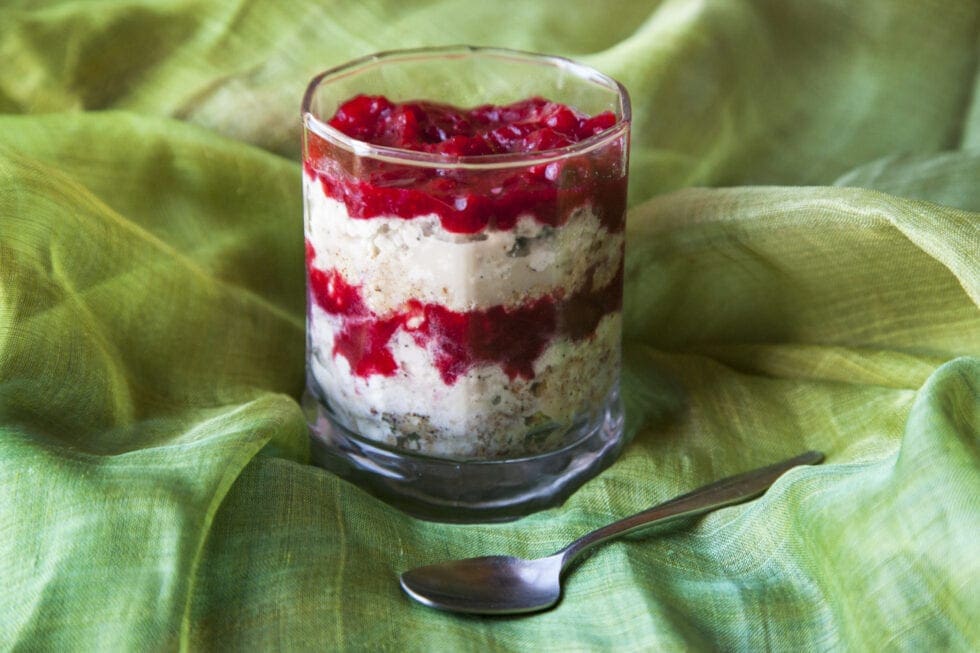
Low Histamine 6 Layer Cranberry Trifle Recipe (also Low Lectin, Low Oxalate)
If you’re not a chef, you might be wondering…what’s a trifle?
Well, have you ever seen pics in a food magazine of a layered dessert of sponge cakes, jams, fruit, nuts, and whipped cream…the kind that was presented in a footed glass serving bowl so you could see all the luscious layers?
That was likely a trifle.
Today, it seems like each celebrity chef has his or her own version of the trifle. And it seems like many families, especially in England, have their own special family recipes, too.
This dessert has a long history, too.
Did you know that trifle recipes have been dated back as far as the 1590s?! If you are a history or literary buff, you’ll know that goes back to the times of William Shakespeare!
Back then, the trifle wasn’t quite what we know it to be now. The early trifle would have been a combo of cream, rosewater, ginger, and sugar.
But by the 18th Century, trifles began to include liquor-soaked cookies, custard, and whipped cream.
Since then, the trifle has had many more variations and adaptations. Now, you’ll see recipes with lady fingers or sponge cake, fruits, and jams.
But looking at those ingredients, you’ll see it doesn’t exactly fit the low-histamine diet.
This is why I’ve got another adaptation for you. This version is great for those of us with Mast Cell Activation Syndrome or Histamine Intolerance.
We can’t have all the sugar, gluten, and dairy that those more traditional recipes call for. But that doesn’t mean we can’t indulge in our very own decadent dessert.
Let’s take a closer look at this Low Histamine 6-Layer Cranberry Trifle.
Choosing Low Histamine Cranberry Trifle Recipe Ingredients – what to know for those with Mast Cell Activation Syndrome or Histamine Intolerance
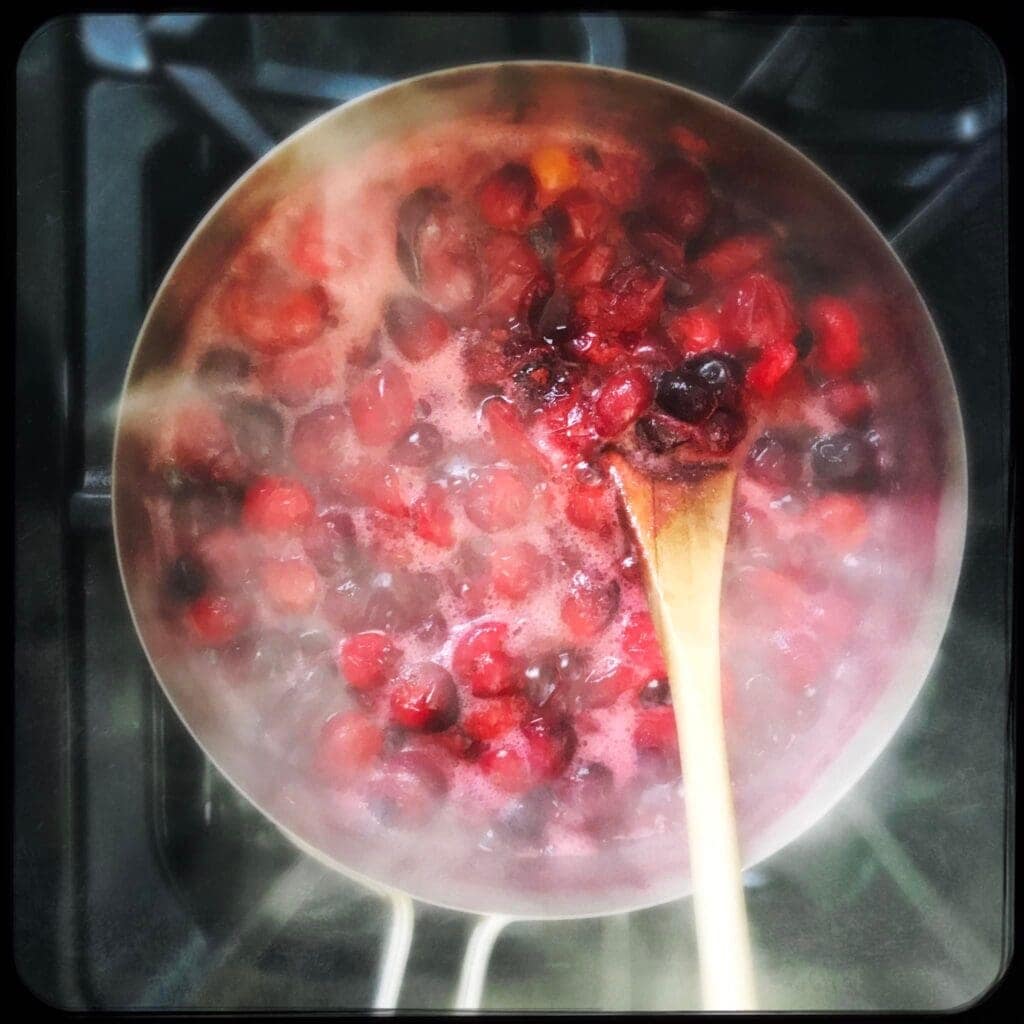
This Low Histamine Trifle recipe uses antioxidant-rich cranberries for the fruit layer. And to keep it dairy free, we used whipped coconut cream for the cream layers.
And since gluten-laden cake isn’t an option, we used another favorite recipe of mine (and our readers) in its place. What did we use? Low Histamine “Cookie Dough.”
Cookie Dough Layer
The trifle starts with a layer of Low Histamine White Chocolate Cookie Dough. It fills in for the more traditional sponge cake or lady fingers.
Quick Note: The Cookie Dough recipe isn’t meant to be cooked. If you do try to bake it, you won’t get cookies. You’ll get a melted mess of ingredients.
But if the cookie dough is cool or at room temperature, the mixture holds together nicely and forms a “crust” type layer. That’s basically the experience you get with the cake or cookie in the traditional trifle.
It’s hearty with a texture that differs from the smoothness of the coconut cream and puréed cranberry layers.
In our low histamine cookie dough, we don’t use white, all-purpose flour. That kind of bleached flour is high histamine. And wheat falls into the gluten category and the lectin category. Both of those can be mast cell triggers.
Instead, this recipe makes “flour” using pecans and macadamia nuts. Nuts are a healthy fat and protein source. Nuts are also rich in Omega-3 fatty acids. Studies have shown that these fatty acids slow down the release of mast cell mediators like histamine.
Now that’s something Shakespeare didn’t have in his trifle!
Cranberries
Another histamine lowering ingredient in this recipe is cranberry. Cranberries have been shown in numerous studies to reduce inflammation, too. Fresh or frozen cranberries are the best choices for lower histamine levels.
There are a couple reasons not to use dried cranberries. The most important reason is that they will be higher histamine. They also won’t cook down the same since the liquid will have been removed in the drying process.
Cranberry is often associated with the fall and winter holidays here in the US. That’s why I’ve chosen it instead of another fruit. If cranberries aren’t your jam, choose a different fruit like blueberries. Or you could make a blend of cranberries and blueberries. That would make a nice sweet-tart variation.
Speaking of sweet…
No Sugar, Natural Sweeteners
In this recipe, we’re getting sweetness from monk fruit extract and stevia.
With Mast Cell Activation Syndrome or Histamine Intolerance, we try to stay clear of sweeteners derived from sugar cane, corn syrup, and even honey. That’s because anything that raises your blood sugar can also raise your histamine levels.
Monk fruit and stevia are excellent choices because they don’t affect blood sugar.
There are a number of monk fruit extracts online. Several contain a sugar alcohol called erythritol that can cause bloating, gas, and diarrhea for many people.
Others just taste awful. They have the same kind of fake sweetness as you’d taste in a diet soda. I’m not a fan. I’ve had to throw out several because the taste was so bad.
The only monk fruit I cook with is Smart Monk 100% Monk Fruit Extract. It has a sweet maple-like flavor. This jar will last you a very long time – likely a year at least.
Coconut Cream Layer
Last, let’s look at the coconut cream layer. You can check out our German Pancake Recipe to learn more about the benefits of coconut, like how studies have shown it can support mast cells and fight candida.
But right now, I just want to highlight a few quick tips you need to know to make sure you get a good, low-histamine coconut cream and that it whips up correctly.
With coconut cream, be sure you are choosing a brand which doesn’t have histamine-raising additives. These are things like carrageenan, xanthan gum, and sulfites.
I keep a stock of coconut cream at my house. The one in the link is just pure coconut cream and water with nothing else added. I use it in everything from baking to coffee to sauces. You can get it here:
And this next step is very important for this recipe. The night before you want to make the recipe, put the coconut cream (unopened) in the fridge and leave it there overnight.
You want to do this so the solids will separate from the liquids. You only want the solids for this recipe.
It should separate. If it doesn’t and still seems to be the same consistency throughout, blend it up on its own before adding any other ingredients. The solids will start to separate from the liquid. You can then strain it, keeping the solids and discarding the liquid.
Low Histamine 6-Layer Cranberry Trifle Recipe – for those with Mast Cell Activation Syndrome or Histamine Intolerance
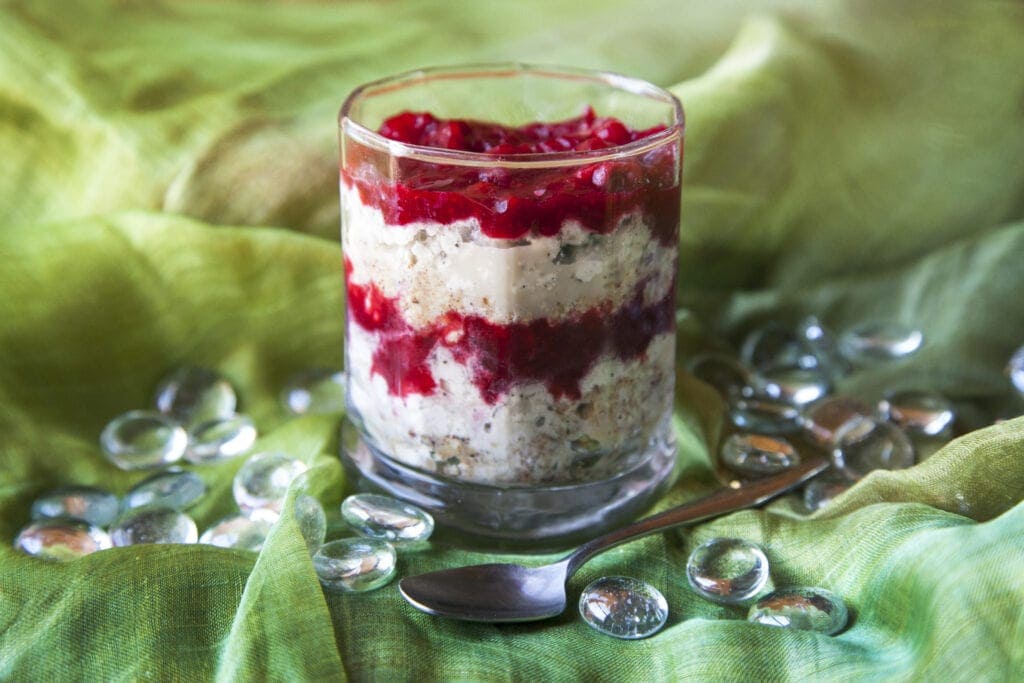
This recipe should yield 4 servings when assembled individually in rocks glasses. These are shorter glasses which can also go by the name of lowball glasses or short tumblers. The one I used for the picture holds 10 ounces of fluid, just to give you an idea about size.
This recipe is made in layers. First, you’ll start with the cookie dough layer.
Cookie Dough Layer:
To serve 4, you’ll need to double this Low Histamine White Chocolate Cookie Dough recipe. Prepare the cookie dough, then set aside in the fridge to chill while you make the next layer.
Cranberry Layer:
- 1 pound organic fresh or frozen cranberries, rinsed and sorted (remove any stems)
- 1 cup filtered water
- 1 teaspoon Smart Monk 100% Monk Fruit Extract
- Optional: Better Stevia, to taste
Directions:
- Add cranberries, water, and monk fruit to a saucepan. Simmer on low for 10-15 minutes until cranberries start to thicken. Stir frequently. (If you are using frozen cranberries, they can go right from freezer to pan. There is no need to thaw. It may take just a few minutes extra, though.)
- Allow it to cool for 10 minutes. Then use a stick blender to purée the cranberries. Blend until smooth. It will still have some texture. (If you prefer a completely smooth purée, then run through a sieve, too. I like a little texture, personally.)
3. This may be sweet enough for you. I like the tartness of cranberries, so this was fine for me. If you prefer more sweetness, add stevia to taste. A little stevia goes a long way, so add just a few drops at a time.
4. Continue to allow the cranberry purée to cool while you make the coconut cream layer.
Coconut Cream Layer:
- (2) – 13.5-ounce cans of coconut cream, chilled overnight in fridge
- ½ teaspoon raw vanilla powder
- 1 teaspoon Smart Monk 100% Monk Fruit Extract
- Optional: Better Stevia, to taste
Directions:
- Separate the solids from the liquids in the coconut cream. If it hasn’t separated by being in the fridge overnight, see note in the section above on coconut cream for a tip.
- Once separated, blend coconut cream, vanilla powder, and monk fruit for about 4 to 5 minutes until smooth and creamy. (If you don’t already have a good blender, here are some good ones you can check out: Blendtec Blender, Vitamix Blender, or Ninja Professional. A food processor or hand mixer would also work.)
- Taste. If it isn’t sweet enough for you, add stevia slowly to taste. Keep in mind the sweetness of the other layers, too.
Assembly:
- Use 4 rocks glasses to make 4 individual servings.
- First layer the “cookie dough” in the bottom.
- Then top with the coconut cream.
- Then add a layer of cranberry purée. If the cranberry is still warm, it will melt the coconut cream layer a little bit. It will still taste fine.
- Repeat the layers 1 more time.
In the comments below, I’d love to hear about any extra special touches you added to your trifle!
Learn more about nervous system support and how it may calm mast cells in our online course: Mast Cell Nervous System Reboot.
More Low Histamine Dessert Recipes
- White Chocolate Cookie Dough – Low Lectin and Medium Oxalate
- Carrot Cake – Medium Oxalate, Low Lectin
- Blueberry Cassava Flour Muffins – Low Lectin and Medium Oxalate & Low Salicylate Options
- Pecan Clusters – Low Lectin and Medium Oxalate
- Ginger Cardamom Breakfast Rolls – Low Lectin, Moderate Oxalate, and Moderate FODMAP
*Some links in this website are affiliate links, which means Mast Cell 360 may make a very small commission if you purchase through the link. It never costs you any more to purchase through the links, and we try to find the best deals we can. We only recommend products that we love and use personally or use in the Mast Cell 360 practice. Any commissions help support the newsletter, website, and ongoing research so Mast Cell 360 can continue to offer you free tips, recipes, and info. Thank you for your support!
References for Low Histamine 6-Layer Cranberry Trifle – for those with Mast Cell Activation Syndrome or Histamine Intolerance
Hagenlocher, Y., & Lorentz, A. (2015, January 1). Immunomodulation of mast cells by nutrients. ScienceDirect. Retrieved November 8, 2021, from https://www.sciencedirect.com/science/article/
abs/pii/S0161589013005853
Karunasiri, A. N., Gunawardane, M., Senanayake, C. M., Jayathilaka, N., & Seneviratne, K. N. (2020). Antioxidant and Nutritional Properties of Domestic and Commercial Coconut Milk Preparations. International journal of food science, 2020, 3489605. https://doi.org/10.1155/2020/3489605
Mayo Clinic Staff. (2019c, November 14). Nuts and your heart: Eating nuts for heart health. Mayo Clinic. Retrieved November 12, 2021, from https://www.mayoclinic.org/diseases-conditions/heart-disease/in-depth/nuts/art-20046635
Pappas, E., & Schaich, K. M. (2009). Phytochemicals of cranberries and cranberry products: characterization, potential health effects, and processing stability. Critical reviews in food science and nutrition, 49(9), 741–781. https://doi.org/10.1080/10408390802145377
Seleem, D., Freitas-Blanco, V. S., Noguti, J., Zancope, B. R., Pardi, V., & Murata, R. M. (2018). In Vivo Antifungal Activity of Monolaurin against Candida albicans Biofilms. Biological & pharmaceutical bulletin, 41(8), 1299–1302. https://doi.org/10.1248/bpb.b18-00256
Siciliano-Rosen, L. (2019, October 4). trifle. Encyclopedia Britannica. https://www.britannica.com/topic/trifle
Times, T. N. Y. (1988, March 27). FARE OF THE COUNTRY; English Trifle: Serious Dessert. The New York Times. Retrieved November 11, 2021, from https://www.nytimes.com/1988/03/27/travel/fare-of-the-country-english-trifle-serious-dessert.html

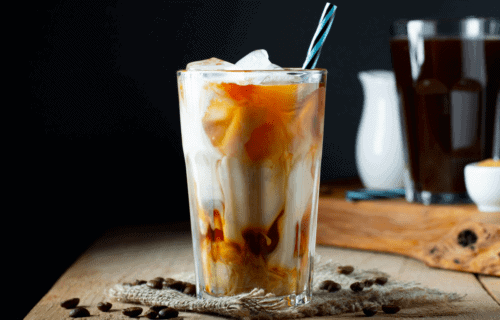
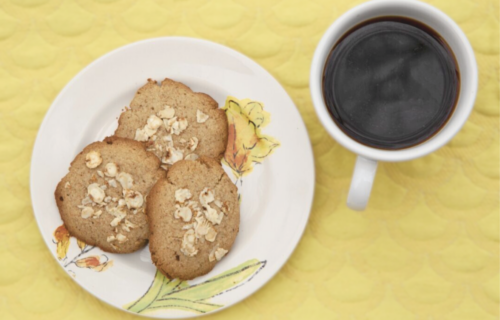
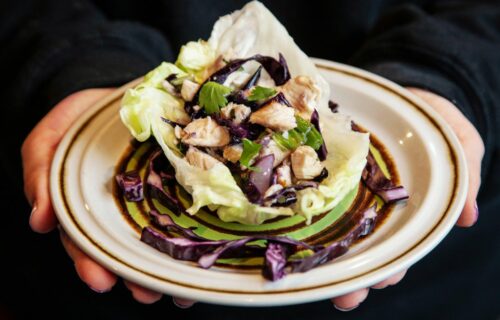
Add A Comment